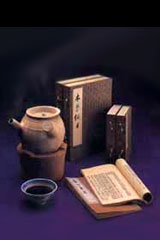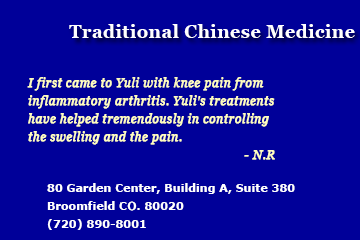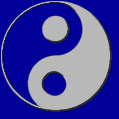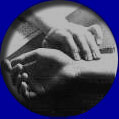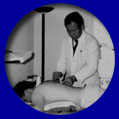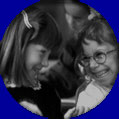| |
The Ancient Eastern Healing Arts |
|
Traditional Chinese Medicine
(TCM) is an ancient eastern healing arts, is a well of medical
knowledge gained from over 4,000 years of observation, investigation
and clinical experience. TCM has evolved as an empirical science and
its theories and treatments have been repeatedly in use and refined
over this long period of time. TCM is holistic healing of the body,
mind, emotions and spirit. It utilizes acupuncture, moxibustion, acupressure,
herbal medicine, and massage therapy. For thousands of years it has
been extremely effective in maintaining good well being and curing a
wide variety of conditions and diseases through its power to simulate
the mind and body's own healing response. In resent years, Chinese Medicine
has gained popularity in the United States due to its good curative
effectiveness, simplicity of application, minimal side effects, and
relative low cost of treatment.
Meridians
or channels form a distribution system that carries Qi, Jing, Blood
and Body Fluids around the body. There are 12 main meridians. Branching
from them is a network of other smaller channels. Each main meridian
is connected to one of the twelve organs and travels along its own
route within the body. For example, the Heart meridian travels in
a pathway from the heart itself to the armpit and down the inside
of the arm to the little finger. This explains why someone with a
heart problem often has a tingling feeling running down the arm to
the little finger.
Acupuncture is an ancient
system of healing developed over thousands of years. The earliest
records of acupuncture date back over 4,000 years and today there
are over 3,000,000 practitioners worldwide.
The Chinese words for Acupuncture is ZhenJiu. Zhen means acupuncture
and Jiu means moxibustion. Acupuncture is the insertion of various
needles into points on the body. These points are located and join
together in 'channels' or 'meridians'. The points used in treatment
are carefully chosen by the TCM practitioner to disperse any blockages
and to bring the patient's Qi into balance, restores and maintains
health and well being. Acupuncture points and trigger points may also
be stimulated using a small electric current.
Moxibustion, as a supplement,
is the process whereby a dried herb is burnt, either directly on the
skin or indirectly above the skin over specific acupuncture points
to warm the Qi and Blood and unblock the channels. Moxibustion is
most commonly used when there is a requirement to expel Cold and Dampness
from the body.
Herbology
 Herbal
Medicine in TCM describes formulae which are made from the roots,
stems, barks, leaves, seeds or flowers of many plants, as well as
some mineral and animal parts. For thousands of years the herbal formula
is a very important part of the ancient east healing arts. For thousands
of years, they are usually decocted into a soup, and for the last
century, the herbs are concentrated 5 - 6 times into powder format,
so patients can simply dissolve it into hot water and drink it, this
will suit the busy schedule of the modern people. Herbal
Medicine in TCM describes formulae which are made from the roots,
stems, barks, leaves, seeds or flowers of many plants, as well as
some mineral and animal parts. For thousands of years the herbal formula
is a very important part of the ancient east healing arts. For thousands
of years, they are usually decocted into a soup, and for the last
century, the herbs are concentrated 5 - 6 times into powder format,
so patients can simply dissolve it into hot water and drink it, this
will suit the busy schedule of the modern people.
There are two different kinds of herbal females: commercial and customized.
The commercial herbal formulas are made according to experiences of
many TCM practioners over hundreds of years, for the most common
diseases, which come in ready-prepared pills, capsules or powder,
called 'patent' herbal remedies. They are available in the holistic
pharmacies. Patients better see a TCM practitioner and get advice from the
practitioner before they buy this herbal formula. The customized herbal
formula is usually taken in the form of a prescription, which is prescribed
by a TCM practitioner based on his/her diagnosis and specifically for the
patient he/she is treating.
Tui Na is
Chinese therapeutic massage. The word 'tuina' actually means 'push
grab'. Some of the common techniques include rolling, pushing, grasping,
kneading, rubbing, nipping, vibrating, chopping, revolving, pinching
and pressing. These techniques are used individually or combined together,
and apply on specific acupuncture points, along a channel or meridian,
or a whole area of the body.
Although best known for its capacity to heal joints, muscular, and
nerve problems and create relaxation, Tuina can help many other internal
and external disorders, too.
 The
word Qi Gong is made
up of two words, 'Qi' and 'Gong'. 'Qi' usually translated as 'energy'
or 'vital energy', is the energy that underlies everything in the
universe. The word 'Gong' can be translated as 'practice'. The word
QiGong conveys the meaning of 'practice concerned with exercising
of Qi'. The use of Qigong to improve and maintain health was first
mentioned in the Yellow Emperor's Classic of Internal Medicine, written
in about 200 BC. The
word Qi Gong is made
up of two words, 'Qi' and 'Gong'. 'Qi' usually translated as 'energy'
or 'vital energy', is the energy that underlies everything in the
universe. The word 'Gong' can be translated as 'practice'. The word
QiGong conveys the meaning of 'practice concerned with exercising
of Qi'. The use of Qigong to improve and maintain health was first
mentioned in the Yellow Emperor's Classic of Internal Medicine, written
in about 200 BC.
Acupuncture Related Information:
|
